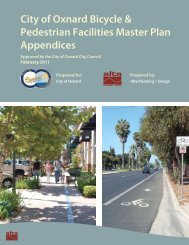View File - Development Services - City of Oxnard
View File - Development Services - City of Oxnard
View File - Development Services - City of Oxnard
Create successful ePaper yourself
Turn your PDF publications into a flip-book with our unique Google optimized e-Paper software.
WATER RESOURCES TECHNICAL REPORTrespectively, which were provided by UWCD. Groundwater levels are shown for bothspring and fall data.UAS Groundwater Levels. In the UAS, groundwater levels are above sea level across theForebay and most <strong>of</strong> the <strong>Oxnard</strong> Plain. However, they remain slightly below sea level inthe southern <strong>Oxnard</strong> Plain and Pleasant Valley area (Figure 2-18). These higher levels arelargely attributed to the effectiveness <strong>of</strong> artificial recharge performed by UWCD in the<strong>Oxnard</strong> Forebay and Santa Clara River surface water provided by UWCD to growers onthe southern <strong>Oxnard</strong> Plain for irrigation in lieu <strong>of</strong> groundwater pumping. Groundwaterelevations for both the UAS and LAS are higher in the spring and lower in the fall,representing increased recharge and reduced pumping during the wetter winter seasonand the decreased recharge and increased pumping during the drier summer season.In the UAS, groundwater levels were between approximately 50 to 100 feet above sea levelin the Forebay during spring 2002 and between approximately 20 to 80 feet above sea levelduring fall 2002. Groundwater levels approach sea level towards most <strong>of</strong> the coastline alongthe <strong>Oxnard</strong> Plain, indicating current seaward flow and no seawater intrusion. One exceptionis at the extreme southern portion <strong>of</strong> the <strong>Oxnard</strong> Plain where water levels were up toapproximately 10 feet below sea level in fall 2002, indicating landward gradients and thepotential for seawater intrusion.LAS Groundwater Levels. In the LAS, groundwater levels are above sea level across theForebay and northern <strong>Oxnard</strong> Plain area but remain significantly below sea level on thesouth part <strong>of</strong> the <strong>Oxnard</strong> Plain and most <strong>of</strong> Pleasant Valley (Figure 2-19). Water levelrecords, stratigraphic interpretations based on well logs and seismic studies indicate thepresence <strong>of</strong> a fault, or some other low permeability structural or stratigraphic feature, thatextends from the western terminus <strong>of</strong> the Camarillo Hills southwest <strong>of</strong> Port Hueneme. Thisfeature, which is exhibited by the tight grouping <strong>of</strong> groundwater elevation contoursbetween the Camarillo Hills and Port Hueneme, appears to limit groundwater flow from theForebay and northern <strong>Oxnard</strong> Plain area to the southern <strong>Oxnard</strong> Plain and Pleasant Valleyareas. This, combined with the clay layers separating the UAS from the LAS, makesrecharge to the LAS in the southern <strong>Oxnard</strong> Plain and Pleasant Valley very slow.Groundwater levels were between approximately 40 and 80 feet above sea level in theForebay during spring 2002 and between approximately 30 to 60 feet above sea level duringfall 2002. North <strong>of</strong> the low permeability feature, groundwater levels in the northern <strong>Oxnard</strong>Plain approach sea level towards the coast line, where groundwater levels remain severalfeet above sea level for both spring and fall 2002 conditions, indicating current seaward flowand no seawater intrusion. South <strong>of</strong> the low permeability feature, groundwater levels in thesouthern <strong>Oxnard</strong> Plain and Pleasant Valley area were up to approximately 40 feet below sealevel during spring 2002 conditions and up to approximately 120 feet below sea level duringfall 2002 conditions. These severely depressed groundwater levels occur over a broad area<strong>of</strong> the southern <strong>Oxnard</strong> Plain and western Pleasant Valley areas and indicate a largepotential for coastal landward flow and seawater intrusion.Recharge and Discharge. Additional sources <strong>of</strong> recharge to and discharge from thegroundwater system have been created as a result <strong>of</strong> development. Some <strong>of</strong> these have beenbeneficial, while others have been detrimental as a result <strong>of</strong> the overdraft conditions.Sources <strong>of</strong> recharge to and discharge from the groundwater system under currentW112003002SCO LW1458.DOC/ 033390002 21
















